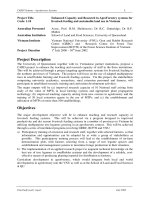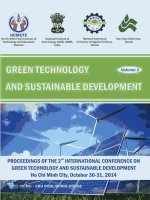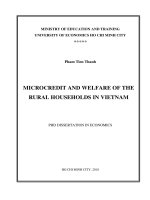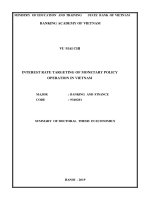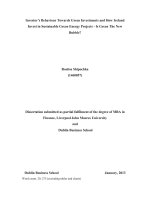International economics report GREEN ECONOMY PROMOTING SUSTAINABLE DEVELOPMENTS APPLICATIONS IN VIETNAM
Bạn đang xem bản rút gọn của tài liệu. Xem và tải ngay bản đầy đủ của tài liệu tại đây (762.47 KB, 51 trang )
MIDTERM REPORT
GREEN ECONOMY PROMOTING
SUSTAINABLE DEVELOPMENTS
& APPLICATIONS IN VIETNAM
TABLE OF CONTENT
I.
Abstract .......................................................................................................... 2
II.
Introduction ................................................................................................... 2
III.
Literature Review .......................................................................................... 4
IV.
Methodology ................................................................................................... 5
V.
Definition – differentiate with other related economic concepts ............... 5
VI.
The Importance of Green Economy: Case study ........................................ 9
a.
With environment ................................................................................................ 9
b.
With economy ................................................................................................... 12
c. With society ...................................................................................................... 16
VII.
Analysis the trend of green growth in the world and Viet Nam using EPI
index 18
a.
EPI framework .................................................................................................. 18
b.
Trend in the world ............................................................................................. 20
c.
Green growth in Viet Nam (Current EPI ) ........................................................ 22
VIII.
a.
The implement in Vietnam ......................................................................... 25
Vietnam Green economy context ...................................................................... 25
b. Vietnam Government’s Policy .......................................................................... 27
c. Economic assessment towards green growth in Vietnam through a number of
indicators......................................................................................................................................................29
d. Solutions to ensure efficiency...................................................................................................34
IX.
Conclusion...................................................................................................................................39
X.
Appendix.......................................................................................................................................41
XI.
References....................................................................................................................................42
1
I.
Abstract
Since joining the WTO in 2007, Vietnam has become increasingly integrated into
the global economy, which is both good and evil. The 2008 global financial crisis,
combined with Europe's increasing public debt, drastically halted Vietnam's thenrapidly developing economy. Vietnam must reevaluate the sustainability of its "brown
economy" and develop strategies toward the adoption of a "green economy" growth
model to alleviate the long-term repercussions of that economic shock and promote
growth adequate to meet the requirements of its citizens. Vietnam is fortunate to be in
a region that has seen rapid economic development and has many advantageous social
and legal conditions for the development of a green economy with its neighbors.
Despite this, Vietnam's economy continues to be fueled by a brown growth model
defined by an overreliance on raw materials production, excessive consumption of
fossil fuels and natural resources, and escalating environmental pollution. To
conclude, although Green Growth initiatives have been implemented in Vietnam for
many years, they have yielded some initial favorable effects while also posing
significant practical issues. This article will examine and evaluate the overall
execution of green growth in Vietnam, as well as the challenges that must be
addressed and make some recommendations based on the findings
II.Introduction
Developing a green economy to achieve green growth has become an inevitable
trend of the modern world economy. Green growth reflects how economies respond to
climate change and natural resource depletion; it reflects the trends of looking for new
growth models with the green industry emerging as a spearhead, creating a new and
highly competitive growth engine. At the same time, it demonstrates governments'
efforts in restructuring the economy towards green and sustainable growth.
The green economy is being promoted as a solution to environmental and economic
problems. Dating back to the last decades, the world's economy has witnessed a tendency
toward integration and sharing economic development experiences, especially after 1945.
For example, the post–World War II economic growth, sometimes known as
2
the Golden Age of Capitalism, was a period of the global economic boom that lasted
from 1945 to 1975, commencing after WWII and ending with the 1973–1975
recession. In particular, the United States, the Soviet Union, Western European and
East Asian countries saw extraordinarily strong and persistent growth, as well as full
employment. However, along with these prominent achievements is the overexploiting energy from fossil fuels and other limited natural resources. As a result,
numerous environmental problems have arisen, including air pollution, water
pollution, soil degradation, forest loss, shortage of resources, et cetera. This old
method of economic development, say, the "brown economy," has not only affected
the environment but also threatened human life and sustainable economic activities.
With a view to addressing the problem, the green economy - a new strategy for
economic development - was promoted by the United Nations Environment Program
(UNEP). Many research and experts believe that it is the green economy that
eliminates ecological shortages and environmental dangers. While doing so, it can
even bring long-term development and tackle the problem of persistent poverty. Up to
now, this model is convinced to be the optimal option for now and the future.
Within the context of the worldwide trend of economic development like today,
Vietnam has begun to acknowledge the urgency of pursuing a "green economy." What
is more, Vietnam is one of the five countries suffering the most devastating effects of
climate change. Therefore, establishing this method is a necessary and wise choice. In
order to lead the progress, it is also very critical to understand the opportunities and
challenges clearly.
In fact, green economy is not a very new term. The Club of Rome's study Limits to
Growth, published in 1972, was a watershed moment. In recent years, the topic of
sustainability has risen to the top of the global agenda. Vietnam's government has also
taken this approach into account since 2012. However, practice in Vietnam shows that
the green concept is still relatively new among the population and many businesses
and has not been applied thoroughly. Being aware of the topic's significance, the
authors will carefully analyze the existing data and documents in order to make the
most appropriate proposals and recommendations. Hence, help promote the green
economy development and application in Vietnam more efficiently.
3
III.Literature
Review
The green economy has been a popular topic since the 1970s, and especially since
October 2008, when UNEP, in collaboration with developed economies, launched the
green economy model. It's important to separate research reports on the green economy
into two categories. The first category focuses on the fundamental concepts, principles,
and perspectives of green economic development. The second group, led by UNESCO
(2011), examines unique problems and development plans in a number of countries and
regions, ranging from green economies to green societies. UNEP (2010), Green
Economy: Success Stories from Developing Countries, Nairobi; Stern, N. (2007), The
Economics of Ecosystems and Biodiversity: Mainstreaming the Economics of Nature: A
Synthesis of the Approach, Conclusions, and Recommendations, TEEB; Robins, N. et al
(2010), The United Kingdom has been struck by green austerity. Climate Change, HSBC
Global Research, OECD, London (2011), Preliminary study on a green growth strategy
for food and agriculture, Paris; UNEP (2010), Driving the green economy through public
finance and fiscal policy reform, Nairobi; J. Stephenson and S. Upton (2010), Strategies
for green growth: Framing and issues, OECD. The publications mentioned above share
the view that a green economy is necessary for sustainable development and is the most
viable economic model for many developing countries despite the high cost of
implementation of the necessary strategies. From such publications, 14 models of green
economic development can be sketched. Although each country has 38 its own models,
the common feature that they share is investment in clean technology, clean production,
efficient use of natural resources and green energy. Despite the significant expense of
implementing the essential methods, the publications mentioned above all agree that a
green economy is necessary for sustainable development and is the most viable economic
model for many developing countries. 14 models of green economic development can be
derived from such studies. Despite the fact that each country has its own model, they all
invest in clean technologies, clean production, efficient use of natural resources, and green
energy.
Clean economy, environment-friendly economy, and green development are the
three key pillars of the green economy in Vietnam, according to researchers. The ten
4
principles of green economy, according to Mr Bui Quang Tuan, are 1) sustainability,
2) existence, 3) healthiness, 4) humanity, 5) fairness, 6) protection, 7) effectiveness,
8) accountability, 9) sufficiency, and 10) responsible innovation. In Vietnam, green
economy development is encouraged in all three areas: economy, society, and
environment. This perspective is reinforced in the National Green Growth Strategy,
which was approved on September 25, 2012. Mr Do Huu Hao emphasized the
importance of green industry as the foundation for the country's green economy
development. While solid financial strength is required for development, Vietnam's
national reserves are thought to be insufficient, negatively impacting the outcome
IV.Methodology
Our research approach is structured as follows. First, we introduce the definition
of “green economy” and other related concepts to have a broad view of this new
economic and social idea, then analyse the detrimental effect of green economy on
environment, economy and society, with many case studies to better demonstrate our
thorough findings and researches. Next, trends of international green growth with two
main contractionary components: greenest countries to adopt its policies and most
polluted countries to avoid their dilemma. Finally, the green economy and how it was
and is being applied in Vietnam is taken into consideration, with the following order:
context, current policies and future endorsements to ensure its long-term efficiency.
V.Definition
– differentiate with other related economic concepts
The definition of the green economy appears to be very diverse. Many experts and
international organizations have come up with their own conceptions of this term. The
European Union believes that "Green economy is a smart, sustainable and fair growth
economy" (European Commission, 2010). According to the Organization for Economic
Cooperation and Development, "Green growth means fostering economic growth and
development while ensuring that natural assets continue to provide the resources and
environmental services on which our well-being relies."(Towards Green Growth, 2011).
The International Chamber of Commerce considered the green economy from a
5
business perspective. It said that "It is described as an economy in which economic
growth and environmental sustainability work together in a mutually reinforcing
fashion while supporting progress on social development. Business and industry has a
crucial role in delivering the economically viable products, processes, technologies,
services, and solutions required for the transition to a green economy."(ICC, 2012).
Meanwhile, the Green Economy Coalition proposed a shorter description "An economy
that provides better quality of life for all within the ecological limits of the planet."
Among these, the United Nations Environment Program's (UNEP, 2011) definition is
considered the most accurate and complete of Green Economic "A green economy as
one that results in improved human well-being and social equity, while significantly
reducing environmental risks and ecological scarcities. In its simplest expression, a
green economy can be thought of as one which is low carbon, resource efficient and
socially inclusive."
Until now, the concept and perception of a green economy have remained ambiguous.
Even though there are numerous approaches to comprehend and interpret it, we can see a
common aim: to reduce the negative impacts of economic activities on the environment
and society. Accordingly, the Green Economy not only sets economic development goals
but also pays much attention to human happiness, social justice, and environmental and
ecological issues. Whatever approach is taken, a green economy always involves three
primary purposes: Low carbon emissions, efficient resource usage, and maintaining social
fairness. In other words, it supports economic growth and boosts employment, reduces the
use of carbon energy and natural resources, and assures poverty reduction targets, all of
which improve the quality of a standard life.
With a broader view, we want to discuss more on the relationship between the
green economy and other related economic concepts.
Prior to the green economy, the world's development was primarily based on the
brown economy. The term "Brown Economy" refers to a widely held development
viewpoint. Within this method, economic development came first, followed by
environmental treatment. “Brown" implies pollution in the environment. In terms of
resource utilization, it's also inefficient. According to the United Nations Environment
6
Program (UNEP), brown economy is considered "an economy focused on fossil energy
sources, ignoring renewable energy alternatives."
The cost of abusing the method of brown economy for development is substantial
for the environment and human health. Proven fact, this concept has caused enormous
damage to the environment, such as increasing greenhouse gas emissions and global
climate change. These consequences have threatened human life and resulted in a loss
of economic activity. It also affects countries' long-term sustainable development
goals. Because of the negative impact of the methods in the green economy, the shift
to applying the green economy is inevitable, and it is a widespread tendency in most
countries throughout the world. Thus, we can say the brown economy and the green
economy are diametrically opposed concepts.
While the brown economy can be considered as the opposite of the green
economy, green growth is quite closely related to this term. However, there are still
certain differences between them. Green growth emphasizes on promoting economic
growth while maintaining a harmonious balance with the natural world - especially,
avoiding pressures that would disrupt the environment's balance, with the ultimate
goal of sustaining growth. There is no guarantee, though, that the gains of Green
Growth will be dispersed fairly across society. Meanwhile, the Green Economy places
a greater emphasis on environmental constraints rather than just ecological balance; in
particular, the Green Economy promotes human happiness and social justice. To put it
in other words, the Green Economy is more comprehensive when paying attention to
sustainable development with all three pillars of economy, environment, and society.
On the other hand, green growth is necessary for a green economy in many places
where poverty exists. This is most likely why, in the early years of the twenty-first
century, Green Growth garnered more attention than Green Economy.
In addition, there is another term, “sustainable development”, which has appeared a
lot and is closely related to the concept of green economy. It can be noted that the concept
of a "green economy" does not, and cannot replace the concept of "sustainable
development”. It is becoming more widely recognized as a viable strategy for achieving
7
it. To put it another way, a green economy is an economic approach for achieving
long-term development goals.
Figure 1 Green economy in relation to sustainable development
The prosperity of
human
Aim: promote equality and
social responsibility
Ecosystem
Aim: ensure the
resilience of the
ecosystem
Economy
Aim: improve
resource efficiency
Indeed, the green economy is also concerned with three main aspects of
sustainable
development
(economic
development,
social
development,
and
environmental development). However, the green economy prioritizes its focus on the
economy (produced capital) and the environment (natural capital) from an ecosystem
perspective. It then uses that as a foundation to promote human prosperity (social and
human capital). This strategy is based on the reality that progress toward sustainable
development must be made based on appropriate economic growth.
Yet, the difference in focus does not mean that the green economy takes human
well-being lightly. On the contrary, factors such as "social justice," "quality," "better
quality of life," "human happiness," and "social justice" have always been strongly
stressed in green economy concerns. In fact, these points are reflected in the process of
the green economy's performance in Europe, which include many indicators relating to
social capital and human capital.
8
VI.The
a.
Importance of Green Economy: Case study
With environment
The green economy is proposed to eradicate environmental pollution in society.
As stated in its definitions and principles, the green economy is resource and energyefficient. It maintains biodiversity and ecosystems while respecting planetary
boundaries, ecological constraints, and scarcity. It was discovered that the natural
environment has long supported the concept of green growth establishment theory.
The environment has provided the foundation for green growth in three ways: adapting
wastes, utilizing resources, and providing environmental services. Green economy
adoption in countries can be beneficial on both economic and social levels, as it helps
reduce pollution and waste of limited resources.
Study case in China
China has been seen investing in green sectors to aim for energy efficiency and
renewable energy. The Chinese government prioritizes renewable energy investment
because it allows the country to address air and water pollution while also reducing the
risk of socioeconomic instability. Among these targets, air pollution is considered the
most crucial reason for the Chinese government encouraging renewable energy.
Intending to prioritize economic growth, China has made very rapid progress. In
2014, with a gross domestic product (GDP) of $17.4 trillion in purchasing power
terms, it overtook the United States as the world's largest economy for the first time.
Moreover, today, this country is still the second economy in the world behind the US,
with a GDP of $12,238 trillion. However, this rapid expansion has resulted in
increased environmental concerns and a greater focus on long-term development.
China has overtaken India as the world's greatest energy consumer and secondhighest SO2 emitter. In some countries, coal is the primary source of sulfur dioxide
(SO2) emissions, especially in China, accounting for 92 percent of its total emissions
(2007). Because of its interaction with other airborne molecules, SO2 is a hazardous
chemical that causes a wide range of health and environmental issues. Respiratory
9
issues, reduced sight, acid rain, and corrosion are just a few of them. Air pollution's
economic and physiological effects have been extensively studied, showing shocking
results. In 2013, Asian Development Bank reported that China has seven of the top ten
most polluted cities in the world. According to the World Health Organization, air
pollution kills about 1 million people in China each year. Meanwhile, a University of
Chicago study also stated that suspended particles are shortening the lives of half a
billion people in northern China by an average of 5 years. In terms of economics, a
large-scale survey conducted by China's Ministry of Environmental Protection in 2013
revealed that 16.1% of the country's land area. According to the RAND Corporation,
air pollution cost China $535 billion in 2012, or 6.5 percent of its GDP, due to lost
worker productivity.
These consequences push China to confront them and propose remedies. This
government has set itself lofty ambitions in terms of increasing renewable energy.
China's commitment to renewables is backed up by the country's vast potential for
both production and consumption. China intends to boost non-fossil fuels in the share
of overall electricity production by 4% to 39% in 2020, within the objectives of the
13th Five-Year Electricity Plan (2016-2020). Non-fossil fuel sources are expected to
account for 20% of the country's electricity consumption by 2030. China is also
predicted to account for 36% and 40% of global solar and wind energy growth in the
next five years, respectively, said the International Energy Agency. China also spends
a huge amount of money on this program, demonstrating its ambition to make China a
leader in the field of green economy. By 2020, more than $360 billion will be invested
in renewable energy development and can create 13 million jobs. The BRICS New
Development Bank has issued a long-term green loan totaling $811 million to its
members to fund clean energy projects. Hardly surprising, China is a member of it.
10
Figure 2: Total SO2 emissions from different categories in China (2005-2019)
Total SO2 emissions from different categories in China
(2005-2019)
25000
20000
15000
10000
5000
0
2005
2006 2007 2008 2009 2010 2011 2012 2013
2014 2015 2016 2017 2018 2019
-5000
Oil & Gas
Coal
Smelter
Total
Unit: kilotonnes per year
Source: author’s research on NASA MEaSURES (partially reclassified)
Although still being such a top emitter, we cannot deny China's efforts in trying to
reduce SO2 as well as its positive results. The country has made tremendous progress in
reducing air pollution since it began implementing a green economy through different
five-year strategies. By the end of 2018, 80% of China's coal-fired power plants had been
converted to satisfy Ultra-Low Emission standards and this index climbed up to 86% after
a year. Compared to its 2011 peak, China's SO2 emissions have decreased substantially by
87%. Since China is expanding its green economy applications in the renewables field,
there is the possibility of even more emissions reductions.
China has already surpassed the United States in terms of renewable energy
generation to be at the top of the world. It is the world's largest generator of wind and
solar energy, as well as the world's largest domestic and international renewable
energy investor. China has several corporations that are big names in the world turbine
production map such as Sinovel, Goldwind, Dongfang. Its ambition to increase the
share of renewable electricity is basically achieved.
11
Figure 3 : China renewable electricity production by source
The Chinese government has recognized the importance of clean energy to the
overall health and survival of millions of residents each year, as well as the country's
economy. Despite being late to the game, China is currently making significant
progress in addressing its environmental issues. We can clearly see that China's effort
into utilizing the green economy is worthy and shows very progressive results. China
and its story of the renewable energy strategy is a typical example of how the green
economy can have an impact on enhancing the environment.
b.
With economy
People now are admitting that the green economy is an excellent method proposed
to boost job creation and steer the economy onto a more sustainable path following the
global economic crisis. All countries benefit from the green economy, including
poverty reduction, job creation. Therefore, long-term development, or even the
positive transformation of the whole economy as well.
12
•
Firstly, green economy eradicates poverty.
The positive relationship between economic growth and poverty eradication is
undeniable. Economic growth will undoubtedly lead to a gradual elimination of
poverty. According to cross-country research, if a country's average income increases
by 1 unit, poverty rates will drop by a double amount.
Study case in Caribe
Let’s take a look at Caribe in 2013 and its way of applying the green economy
method in boosting economic growth and gradually removing poverty. In Caribe, with
the context of deteriorating educational performance contributing to fast-rising
unemployment rates, poverty and near-poverty levels have risen. The region features a
high number of female-headed households, with many living in poverty or close to it.
The continuance of poverty here may be due to underproductive local sectors and
reliance on fluctuating external markets. In addition, the government debt has risen
dramatically, with combined external and domestic debt levels ranging from over 70%
at that time. The expense of debt payment has reduced state capability, exacerbating
the economic crisis. The weight of the changes to public services has fallen
disproportionately on those who need them the most, adding to increased poverty and
social inequalities.
This context prompts the Caribbean to propose urgent and effective green economic
measures. A more secure, inclusive, and democratic basis is required to change to a more
resilient and green economic route. A continuous discussion of what a Green Economy
entails in the Caribbean and its implementation is necessary. Hence, after analysis, the
country came up with some highlighted principles of the green economy as listed below.
Industries must try their best to optimize the demand-supply link between domestically
produced goods and services. Among the proposed practices, the best are chosen to
reward, while the worst are removed and discouraged. Businesses that generate net flows
of monetary, societal, and environmental advantages are known as "triple bottom line"
businesses. Specific groups' needs and constraints, such as female single mothers, are
addressed through labor and welfare processes and regulations.
13
Caribe also pays attention to education for young people, providing them with relevant
knowledge and skills necessary for their lives and future employment chances.
Wherever possible, reliance on imported or high-carbon energy sources is lessened.
Natural, human, cultural, and physical resources are efficiently utilized based on
realistic appraisal and application. Intersectional and regional economic links that are
positive and mutually reinforcing are established. From the graph, we can clearly see
that the Caribbean and Latin American countries have seen a fairly steady decline in
poverty rates by adopting a green economy.
Figure 4: Poverty rate in Latin America & the Caribbean from 2000 to 2020.
40
30
20
10
0
200020012002200320042005 2006 2007 2008
2009 2010 2013 2014 2015 2016 2017 2018 2019
Latin American & the Caribbean
Source: LAC Equity Lab: Poverty - Poverty Rate, Worldbank.
•
Secondly, green economy creates jobs.
Economic expansion leads to more work opportunities and, as a result, a higher
demand for labor. In the reverse way, boosting employment has been critical to
achieving faster growth. In today's globe, the trend toward a green economy has
prevailed. The green economy offers enormous potential for boosting the quality and
number of green jobs, in addition to its promising benefits to the environment and the
economy.
14
According to the International Labour Organization (ILO), a change to a greener
economy might result in 24 million new jobs in the world ten years from now, if the
proper policies are implemented. New jobs will most likely be created by adopting
sustainable energy practices, employing electric vehicles, and enhancing energy
efficiency in existing and future buildings. Based on predictions as well as practical
study, the green economy is believed to have the potential to lift millions of people out
of poverty and provide better livelihoods for current and future generations.
As similar to the green economy, green jobs also have a mixture of definitions.
Our findings, based on multiple concepts and perspectives, suggest that these jobs may
be varied but have one thing in common: all stem from the intention to boost
sustainable development and protect the environment. Green employment assists
businesses and economic sectors in reducing their adverse environmental effects,
gradually reaching a stable system. Green jobs aim to reduce energy, raw material, and
water consumption. They are primarily resorting to strategies that cut greenhouse gas
emissions, decrease or eliminate all sorts of waste output and pollution, as well as
conserve and restore biodiversity.
Study case in South Africa, South Korea and the United States
Aware of the importance and inevitability of green economy and green jobs
expansion, the South Africa government has shown its determination to develop this
method for its people. The extremely high unemployment rate and its enormous carbon
footprint are the two primary reasons for which South Africa follows the green economy
strategy, particularly expanding green jobs. The impending national green jobs strategy,
as well as other policy and legal frameworks, must be completed as soon as possible.
Jacob Zuma - South Africa president, declared 500,000 jobs would have to be produced
by December 2009. Given that every industry across the world was grappling with
employment losses at that time, this was a risky but ambitious approach. The most
significant obstacle will continue to be the skills gap. The country ensures that the strategy
includes employment, good work, and social inclusion by implementing appropriate
social and labor market policies, emphasizing skills and education to make
15
career transitions easier, hence increasing employability. Moreover, it also guarantees
everyone has the same opportunities, especially women.
South Korea is another example. The government has taken the lead in directing
the economy in the direction of green growth. The investment in the The Four Rivers
Project to clean up the rivers has been invested in 1.5 billion dollars, and has resulted
in the creation of 350 thousand employment. These projects not only improve a
nation's ecological structure, but its productive natural capital as well. The same
context goes with India, because biomass gasification might provide 900,000 jobs here
by 2025. Meanwhile, the US also follows the trend of expanding green jobs, as the
proportion of workers in such green industries is much more than the old ones. For
example, there are 2.3 million people working in the renewable energy sector
compared to only 2 million in the oil refining market. It is predicted that the US would
have a massive multiplier effect on employment, given its renewable energy portion of
the total energy mix increased by five times, from 5% to 25%.
c.
With society
We all confirm that the green economy stimulates greater power and voice among
the poor by, for example, strengthening their rights to a safe and clean environment,
functioning ecosystems, food, and health. It also promotes human safety by preventing
or addressing conflicts over land ownership, food, water, and other natural resources,
and so on. Above all, a green economy aims to enhance the living standards of all
people and distribute equality between different social classes.
Study case in Ethiopia and the United States
Ethiopia's green economy transformation began in 2011 with the adoption of the
Climate-Resilient Green Economy Strategy. By 2025, it advances Ethiopia's goal of
becoming a middle-income country with a low carbon level and then enhancing the
population's living standards. With over 60 more significant investment projects
launched, this method encourages resource-efficient, low-polluting alternatives to
boost economic growth. The country decided to implement the investment within four
sections: agriculture, forest, renewable energy, and technology. Each category is
16
proposed with different practices. For particular, improving grain and livestock
production, conserving and re-establishing forests, widening the proportion of
electricity by renewables, and advancing to modern technology, respectively. One of
the outstanding achievements of the government's policies is the sufficient supply of
electricity for the population here. In Sub-Saharan Africa, around 600 million people
do not have access to electricity, including Ethiopia. This index witnesses a
considerable drop by advocating for increased renewable energy production and
availability in the region.
Taking the Clean Energy Investment of the US in 2009 as an evidence of how
green the economy can positively affect the society, in particular, reduce the inequality
of society. During presidential campaign for President in 2008, Barack Obama stated
to help and invest federal money into the green energy industry in the United States
and plan to put 460,000 Americans to work on renewable energy projects and double
the amount of renewable energy produced over the next three years. The 2009 Clean
Energy Investment was a part of the American Recovery and Reinvestment Act of
2009 and it increased federal funds in renewable energy. The package included $50
billion in spending and $20 billion in tax provisions. The investment also included a
boost for "green buildings", energy research, and energy-efficient affordable housing.
Environment America, an organization of state-based, environmental advocacy
organizations, reviewed the final bill and stated there was $32.80 billion in funding for
clean energy projects, $26.86 billion for energy efficiency initiatives and $18.95
billion for green transportation, totaling $78.61 billion just for "green" projects. Table
1 presents the Benefits of the Clean Energy Investment Program for Low-Income
Households in the United States. This outcome is a summary based on the paper
“Green Prosperity: How Clean-Energy Policies Can Fight Poverty and Raise Living
Standards in the United States” (2009). After this investment, employment
opportunities for lower-income working people were expanded, more jobs across all
educational levels were created. The cost of home heating and utility bills were
cheaper because of energy efficiency retrofits. Besides, this investment also improved
public transit which reduces transportation expenses.
17
Table 1: Summary the Benefits of the Clean Energy Investment Program (2009)
for Low-Income Households in the United States
Action
Result
Moving from
unemployment
to employment
• 1.7 million new jobs overall
• 870,000 jobs for workers with low education levels
• Newly employed low-income workers can lift
themselves and family out of poverty
Falling unemployment
produces
• Average low-income worker could see a rise in rising
wages earnings of about 2% as unemployment rate falls
1%
Building retrofits lower
home heating and utility
• Retrofits could reduce living costs by up to 4%,
depending on the climate and quality of current housing
• Requires well-designed policies to create market for
retrofits for homeowners and renters so benefits of
retrofits are shared by renters
Improved public
transportation
• Accessibility of public transportation could improve
considerably through targeted investments
• Increasing public transportation use in urban centers to
around 25%–50% of total could reduce living costs by
about 1%–4%
• Households able to replace a car through increased
public transport use could save roughly 10% of total
living costs
Source: Pollin, Wicks-Lim, and Garrett-Peltier 2009.
VII.
Analysis the trend of green growth in the world and Viet Nam
using EPI index
a.
EPI framework
Using the Environmental Performance Index (EPI), this section assesses the overall
level of environmental performance in countries around the world. The EPI was created in
collaboration with the World Economic Forum by Yale University and Columbia
University to produce a relatively complete measurement of national environmental
18
